THE PROBLEM AND CHALLENGE OF DISABILITY AND REHABILITATION IN LEPROSY
ABSTRACT
The epidemiological and demographic pattern of persons with leprosy-related impairments is examined from published literature, unpublished studies and data available to the author on personal enquiries. The significance of this information for rehabilitation of leprosy-affected persons is discussed in this paper and a strategy for their rehabilitation is briefly outlined.
INTRODUCTION
Deformities are the most striking manifestation of leprosy, and hence, when one thinks of a remedial action in the context of leprosy, the term 'rehabilitation' is usually suffixed, as in 'medical rehabilitation' which refers to provision of anti-leprosy treatment, 'surgical rehabilitation' referring to re-constructive surgery, and 'physical, social, vocational, economic and spiritual rehabilitation'. There is even a term 'preventive rehabilitation', which refers to all procedures required to prevent the future need for rehabilitation (1,2,3). In spite of this emphasis on 'deformities' and 'rehabilitation', it is surprising to find that relevant information is hardly available. This paper puts together the available data to get an overview of the situation regarding deformities, disabilities and rehabilitation in leprosy.
The terms 'impairment' and 'disability' as in the International Classification of Impairments, Disabilities and Handicaps (ICIDH) (4) are applicable in leprosy, but the term 'handicap' needs further elaboration into three stages, namely, 'handicap', 'dehabilitation' and 'destitution' (5). Despite efforts by authors to popularise them (6,7), the ICIDH terminology has not caught on, with the exception of 'dehabilitation', which refers to the process of social estrangement and progressive loosening of social bonds between the affected person and his micro-society, including his family, which culminates in the ejection of the affected individual, usually to an urban colony of leprosy-affected persons. The term 'disability' continues to be used as a synonym for impairments and deformities. Even the WHO expert committee on leprosy continues to use 'disability grading' while referring to grading of impairments (8). In view of this common usage of terminology, the term 'disability' in this paper will actually refer to impairments.
MAGNITUDE OF THE PROBLEM
Data on the magnitude of the problem of leprosy-related impairments are not easily available. Even organisations carrying out disability prevention programmes are unable to provide demographic data regarding leprosy-related impairments in their areas. The available information is usually confined to persons with 'grade 2' disabilities among new cases, defined as 'the part affected and/or visible changes present'. In order to present an overview, this paper reports information from published literature, unpublished studies and personal communications.
Prevalence
Prevalence of persons with leprosy-related deformities and disabilities is usually expressed as a percentage of leprosy patients, now defined as 'a person showing clinical signs of leprosy, with or without bacteriological confirmation of the diagnosis, and requires chemotherapy' (9). Persons cured of the disease, who by this definition cannot be called 'leprosy patients', are not included when prevalence is reported. Information on prevalence of persons with leprosy-related deformities and disabilities is usually available only about the grade 2 disabilities. However, grade 2 impairments do not arise de novo, and it is usually the patients of grade 1, with only anaesthesia, who develop grade 2 impairments.
Andhra Pradesh in India with a population of about 67 million people is reported to have 80,595 leprosy-affected persons with grade 2 impairments, giving a prevalence rate of 12.03 persons per 10,000 population (10). The prevalence of persons with leprosy-related grade 2 impairments in the different districts of the state varies widely, from 6.7 to 26.2. In some studies of smaller populations of 300,000 to 600,000 from other parts of South India, the prevalence of persons with grade 2 disability was higher, at 30.8, 45.3, 61.8. and 71.9 (11). These wide variations reflect the non-stochastic distribution of cases of leprosy, which is characteristic of the disease. Therefore, besides estimating the prevalence for very large populations, it is necessary to estimate the prevalence of smaller populations as well, for purposes of planning of intervention programmes.
Risk of development of impairments
The WHO estimates the risk of impairment occurring de novo while under multi-drug therapy to be about 1-5 per 1000 person years (12). A recent study from Bangladesh found that paucibacillary (PB) and multibacillary (MB) leprosy patients having no nerve function impairment at the time of starting multi-drug therapy had 1.8% and 14.4% risk respectively, of having nerve function impairment at the time of completion of anti-leprosy treatment (13). A preliminary analysis of data on 1765 leprosy patients from the Indian Council of Medical Research (ICMR) unit for epidemiology of leprosy at Avadi,, Madras in southern India shows that paucibacillary and multibacillarty patients having no impairments to begin with had about 1% and 27.3% risk respectively, of having some impairment by the time their anti-leprosy treatment was completed (14). A study of 151 multibacillary cases from Delhi shows that those having no impairment at the time of starting treatment had 8.33% risk of developing some impairment later, during a five-year follow-up (15). A study of 657 multibacillary patients from China found that during multi-drug therapy and follow-up, 2.4% developed deformities (16). It appears that the risk of impairments occurring de novo among leprosy patients put on treatment is quite small.
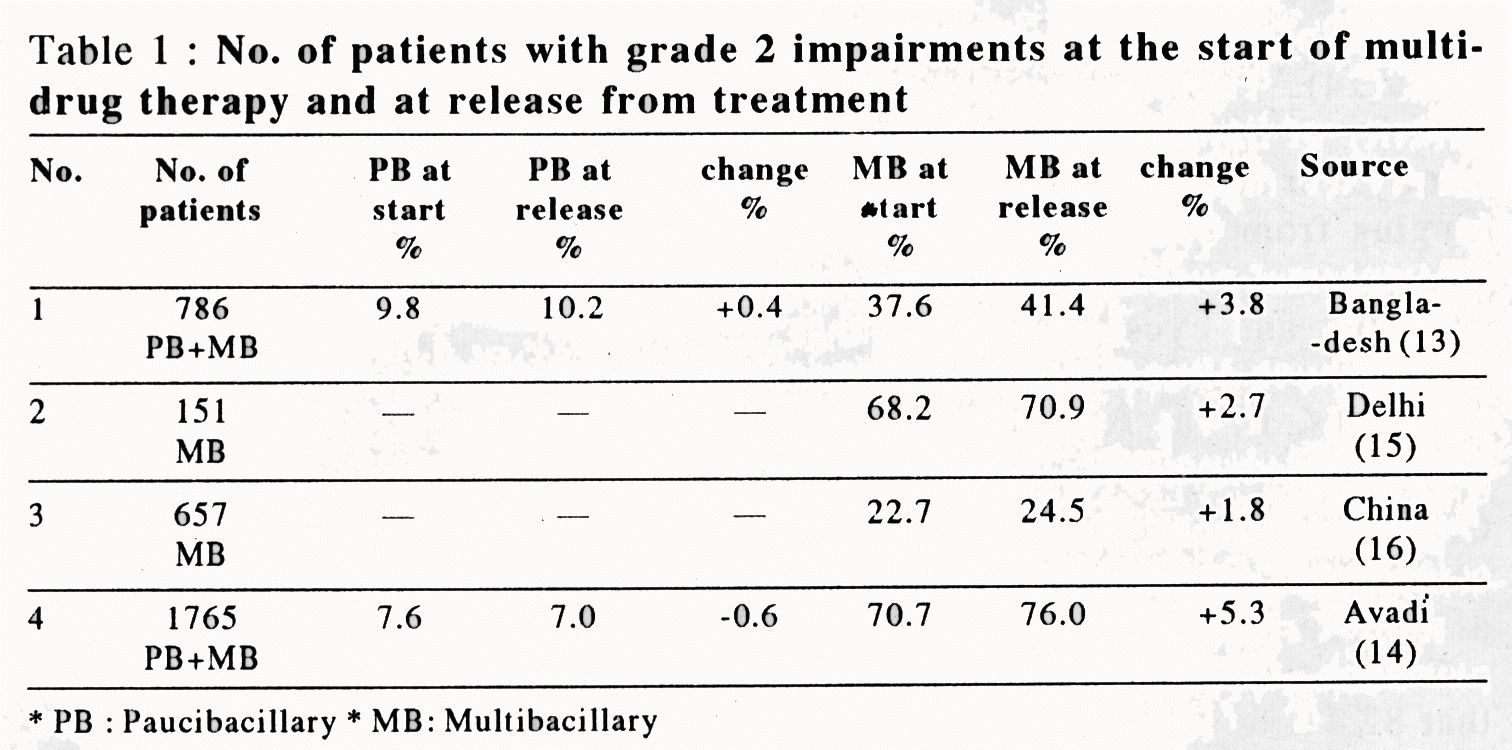
Table 1 shows the proportion of leprosy patients having impairments at the time of starting anti-leprosy treatment and at the time of its completion. It is seen that most persons with impairments had already developed some impairments by the time treatment was started, and only a few fresh cases enter the group of those with impairments subsequently. The corollary is that disability prevention using medical technology such as early recognition and adequate treatment of reaction or neuritis, will have only a very limited impact. This effect will become noticeable only after a few decades.
SEVERITY OF IMPAIRMENTS
The impairments seen in leprosy-affected persons range from a mild degree such as a small area of anaesthesia on the hand, to a very severe degree such as shortening of fingers and thumbs in both hands, bilateral wrist drop, ulceration and fixed deformities of both feet rendering them useless for walking, and loss of vision in both eyes. However, the milder ones are more common. Therefore, instead of grouping all persons with impairments together, it may be more meaningful to group them according to the severity of impairments. At present however, there is no consensus on what is a severe impairment and no agreed measure of severity. The different studies quoted in this paper have also used different criteria to grade severity of impairments.
Grade 2 disabilities are more severe than grade 1 disabilities. The limited data available in literature do not permit generalisation or estimates of the relative frequencies of grade 1 and grade 2 disabilities. Table 2 shows information on grade 1 and grade 2 disabilities collected from published sources and personal communications.
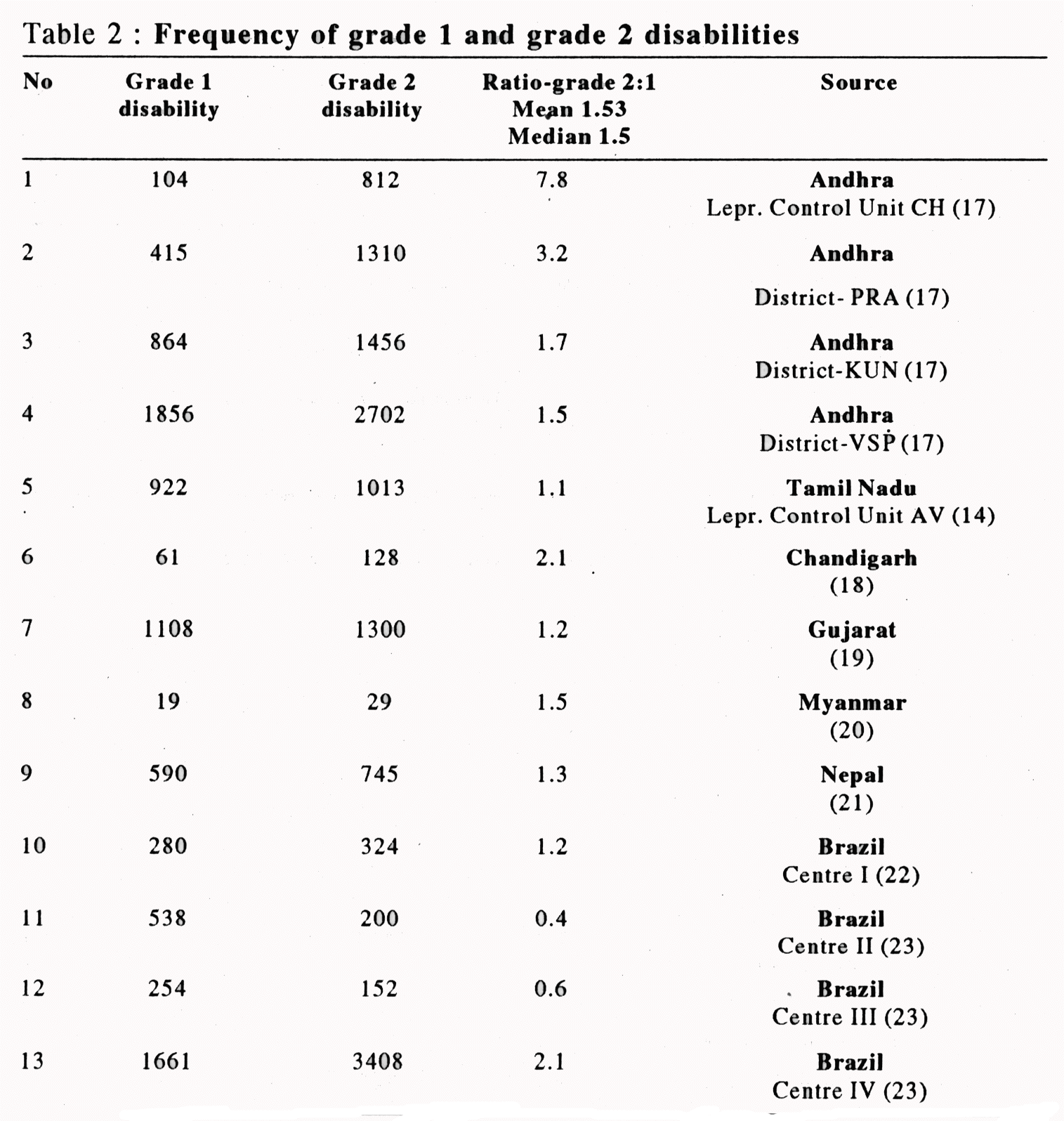
These studies show wide variation in the ratio between grade 2 and grade 1 disabilities, ranging from 0.4 to 7.8. However, it can be presumed that approximately 60 to 70% of those with impairments have grade 2 severity even though they include mild disabilities such as mild clawing, along with the more severe grade 2 disabilities, such as impairments involving all the four limbs and both eyes.
In a study conducted in 1993 in Cuttack, India, 271 persons with leprosy-related impairments were identified from a sample of 671 leprosy-affected persons (24). They were assessed for severity of impairments using an arbitrary scoring system, with the scores ranging from 0 (no impairments) to 22 (maximal possible impairment of all limbs and eyes). Assuming that scores above 10 indicated severe impairments, it was found that 28.4% had scores above 10.
One report from Karnataka, India considered "irreversible" impairments as more serious than "reversible" impairments (25). The authors found that 82.4% of impairments were 'irreversible'. In another study from Nigeria, the author considered secondary impairments, lagophthalmos and wrist drop as 'more serious' impairments and found 28.4% of 603 impairments in 159 leprosy-affected persons to be 'more serious' (26).
Involvement of more than one body part such as hands, feet or eyes may be considered as more severe than involvement of only one body part. In Andhra State, 38,596 or 47.9% of 80,595 persons with leprosy-related grade 2 impairments had multiple body part involvement (10). Similar figures for other areas, obtained through personal enquiry by the author, show that the figure for Western Nepal is 52.2% (21), Bhawani Control Unit is 37.9% (27), Chittoor Control Unit is 71.1% (28), and TNpur Control Unit is 37.7% (29) and Balrampur Control Unit is 38.3 % (29). According to this criterion, about 40 to 50% have severe impairments.
Ocular morbidity is a more serious impairment than those involving hands or feet, even in early stages before it causes significant dimness of vision, or both eyes are affected. Ocular morbidity distresses and incapacitates the affected person greatly. Data on ocular morbidity are not readily available even though specific enquiries reveal an alarming situation. In Andhra State, 17,477 or about 22% of those with leprosy related impairments were found to have some ocular morbidity with serious dimness of vision (10). In Kumbakonam in Tamil Nadu, 45% of 237 multibacillary cases had eye involvement even at the time of starting multi-drug therapy (30). A long-term follow-up of 649 leprosy-affected persons with both paucibacillary and multibacillary types, found that 30% of them had had leprosy-related ocular problems at some time (31). A survey of 6000 leprosy-cured persons In West Bengal showed that 36.4% of them had ocular morbidity (32). It appears that at least 20 to 25% of persons with leprosy-related impairments have ocular problems.
Ulcers may also be considered as serious or potentially serious impairments, in view of their propensity to cripple the person. As with the other impairments, reliable information is not easily available about the prevalence and incidence of plantar and palmar ulcers. Because of its tendency to heal and recur, incidence figures are important to inform about the efficacy of an ulcer prevention programme. Some of the available information on the frequency of ulcers found in hands and feet is summarised in Table 3.
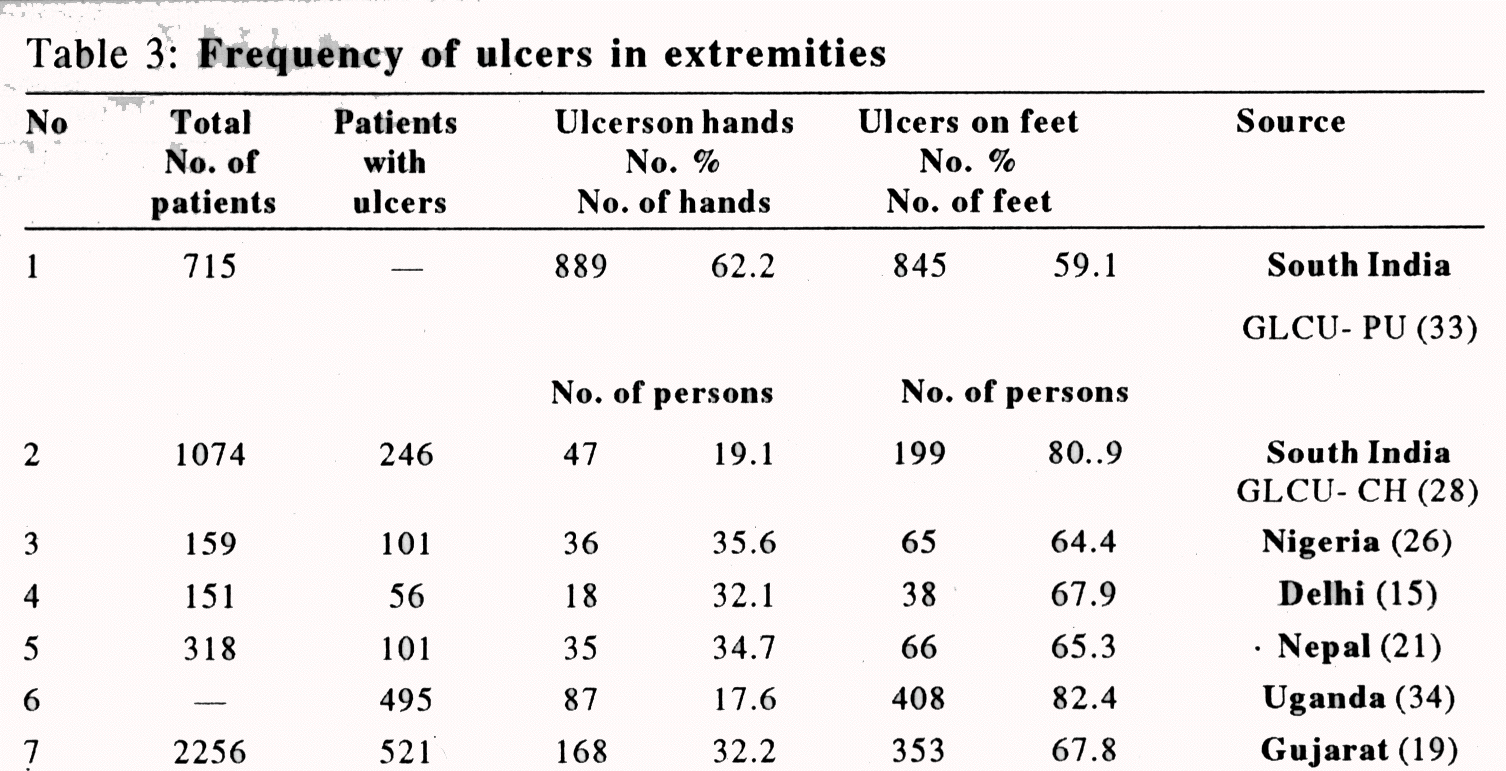
Most of these reports include only the ulcers and not the scars. Also they do not take into account ulcers and scars of the hand. Ulcers and scars were specifically looked for in hands and feet in only the study from Puttoor (33). It was found that about 60% each of hands and feet showed ulcers or scars. Thus, the available reports underestimate the risk of ulceration of anaesthetic extremities and the risk of injuries to the hands in particular. In order to get a realistic estimate of risk of injury and ulceration in anaesthetic hands and feet, scars should be considered as 'potential ulcers' and ulcers as 'broken down scars'.
DYNAMICS OF IMPAIRMENTS
Impairments in leprosy are not static during the period of treatment and for some time thereafter. Impairments may improve, or, they may worsen and new impairments may appear during this period. Information from two studies is summarised In Table 4.
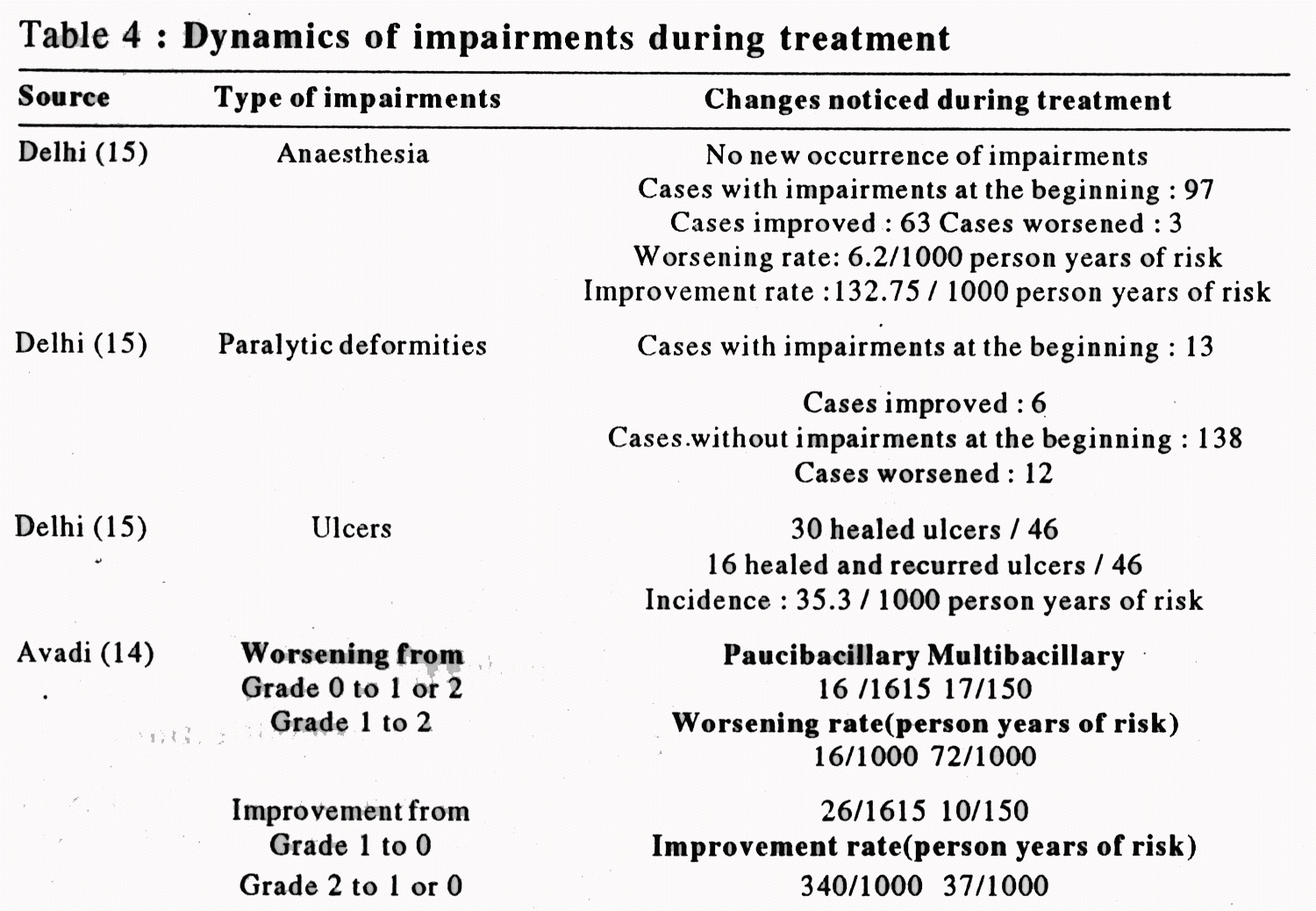
Table 5 shows the findings from a retrospective cohort study from Bangladesh about the occurrence of new nerve function impairment and recovery with and without steroid therapy in 786 patients (13).
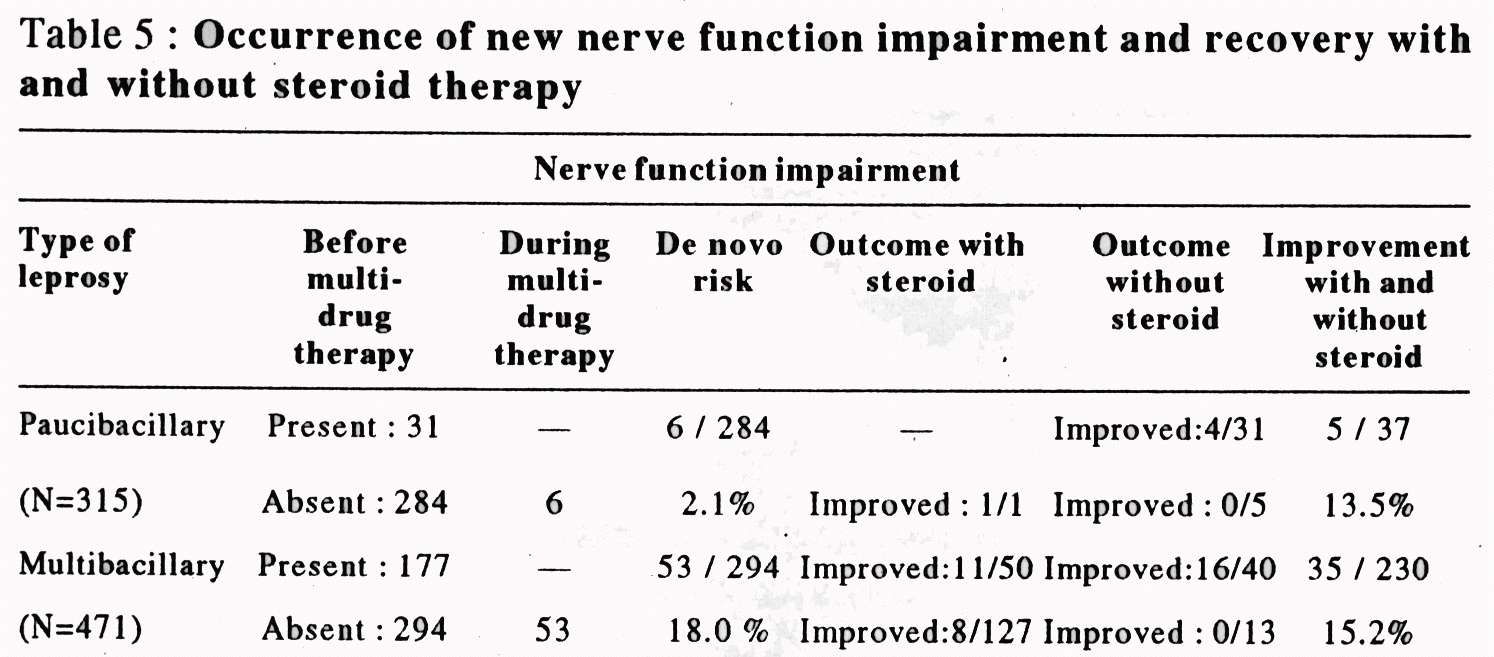
These data give some indication of the dynamics of impairment in leprosy patients under treatment and for some time after treatment. It is seen that among the variables that affect the rates and directions of change, the type of leprosy is an important one. It should also be noted that recovery may be expected in a significant proportion of paralysis of recent, that is, less than 6 months onset, with steroid therapy, and on multi-drug therapy alone. Further studies are required for the identification of the latter group.
CONSEQUENCES OF IMPAIRMENTS
Leprosy gives rise to many other problems besides the medical ones. There are some published reports which shed light on these aspects. Death rate is a crude indicator of the overall effect of the disease and its consequences. Preliminary analysis of data from the Indian Council of Medical Research unit at Avadi covering about 3000 leprosy-affected persons, showed that the crude death rate progressively increased from 18.9 to 88.4 per 1000, with increasing disability grading from grade 0 to grade 3. After standardising for age and sex, the rate was higher still among those with grade 2 and grade 3 disabilities compared to those with grade 0 or grade 1 disabilities (14).
Unlike the biomedical consequences, the psycho-social consequences extend beyond the affected persons to affect their families as well. One study of 500 families in two districts in South India showed that the proportion of families facing social and economic problems increased from 6% to 57% when the family had a leprosy patient with deformities, compared to families that had a patient without deformities (35). If one assumes that about 25% of leprosy-affected families have at least one person with leprosy-related deformities, about 19% of leprosy-affected families would have social and economic problems. According to another study involving about 53,550 patients, about 80% had no deformity, and of this group, 25% had social and economic problems, while, among the 20% who had deformity, 75% had social and economic problems, dehabilitation and destitution (36). These data suggest that about 35% of leprosy patients and their families face social, economic or combined social and economic problems, dehabilitation or destitution.
Social isolation is a major social problem experienced by leprosy-affected persons, which in many instances may be self-inflicted. In the Avadi study (14) involving 410 persons with leprosy-related deformities, it was found that about 8% experienced social isolation as evidenced by not being invited to social or family gatherings. However, about 30% of those invited did not attend the gatherings, which indicates the extent of 'self-isolation' among leprosy-affected persons. Generally we tend to equate social ostracising and stigma with deformities in the context of leprosy. That this need not be so is shown in the example from the study cited above (36) and in another study from Orissa (24). In the latter, out of 671 leprosy-affected persons, 308 had indicated that they were being socially isolated to varying extents. Of these, only 150 (48.3%) had some leprosy-related impairments and the other 158 (51.3%) had no impairments whatsoever. Another study of dehabilitation of leprosy-affected persons conducted by the International Leprosy Union in two different States of India reports that 43% of 1071 dehabilitated leprosy-affected persons had no deformities when they left their homes (37). One corollary of these findings is that the presence or extent of deformities and impairments is not the only criterion for inclusion of a person in a rehabilitation programme; psycho-social dehabilitation should be an equally important criterion. The other corollary is that rehabilitation programmes should always include specific measures to raise the self-esteem of the affected persons.
REHABILITATION
The author views 'rehabilitation of the disabled persons' as an attempt of the society to prepare and equip all its members to lead a meaningful life. To become 'dehabilitated' is to get devalued, dispossessed of one's roles and functions in society, lose one's social identity, and exchange one's multidimensional social identity for a stereotype. 'Rehabilitation' is the process of reversing this phenomenon which enables one to repossess one's role and functions in society. The definition of an individual's role is in respect to his immediate social milieu, and the processes of dehabilitation as well as rehabilitation involve interactions between the affected individual and the local community. One must also recognise that there are two different dimensions to dehabilitation. The economic dimension refers to the material impoverishment of affected individuals and their families, while the social dimension has to do with marginalisation, isolation and rejection leading to impoverishment of social relations. The two are inter-linked, but not so rigidly as to be totally identified with each other. Further, the 'social consequences' are multidimensional and context-dependent. Thus, the 'social aspects' are far more complex and not all of them are easily amenable to manipulation. Planning a rehabilitation programme for dehabilitated persons requires planners to become familiar with the characteristics of their target population.
Age composition
Studies about leprosy-related impairments and disabilities show that deformity rates increase with age (18, 38, 39,40). As a result, a higher proportion of persons with leprosy-related impairments tend to be older adults. Table 6 shows the proportion of persons above 45 years among those having grade 2 impairments.
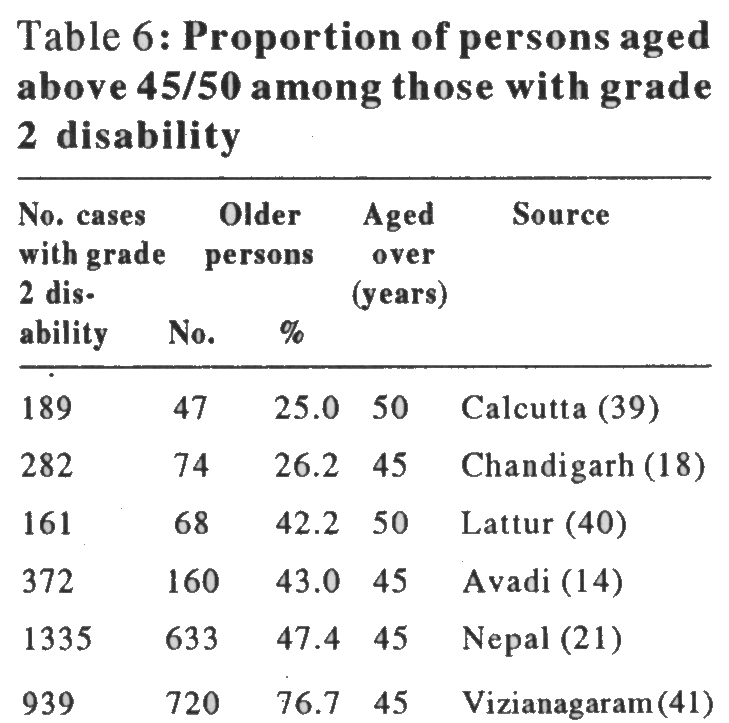
Family size
There is inadequate information on the pattern of family size and impairments of leprosy-affected persons. One study from Orissa (24) found a fairly strong negative correlation between family size and disability score as shown in Figure 1.
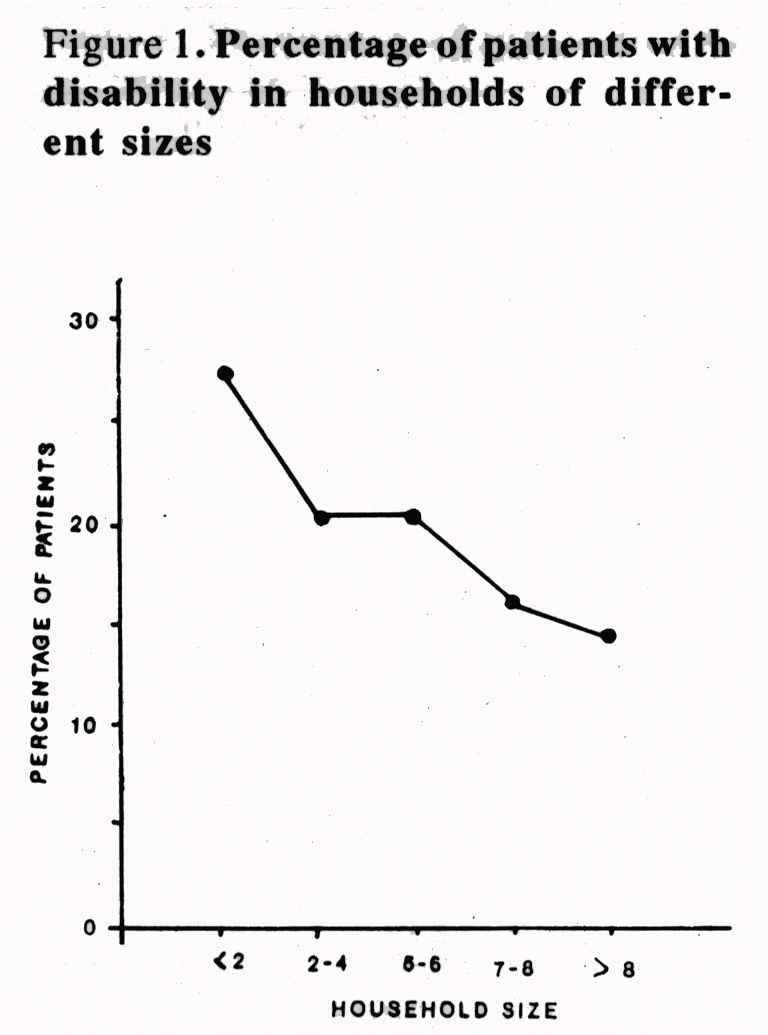
Since family support plays a crucial role in preventing dehabilitation and in coping with economic and social adversities, it is important to have information on the families of affected persons and the resources at their command.
Other features
Variety, multiplicity and worsening are the main features of leprosy-related impairments and disabilities. They vary widely, and include different degrees of loss of skilful use of the hands due to anaesthesia, muscle paralysis, ulceration, digital shortening and stiffness of fingers, loco-motor disability due to plantar ulcers, foot-drop, chronic infection of the foot and tarsal disorganisation, and ocular morbidity. A significant proportion of affected persons have multiple body part involvement. Most commonly, both upper and lower extremities are affected. Impairments are not static; they are often mild to begin with and worsen in course of time, over a few months to a few years, either on their own or because of development of secondary impairments. The worsening occurs in spurts, due to injury, infection or inflammation. Unless disability prevention measures are taken, the worsening is inevitable, in spite of the cure of the disease, surgical correction of deformities, or vocational rehabilitation. By the time the disabilities become serious, the affected person will also be well past middle age. One may expect 25% to 40% of the affected persons to be women, with different problems from those of men. A majority of the affected persons needing rehabilitation are older adults from rural areas, illiterate, and depend on agriculture with no other marketable skills. They are also likely to be widely dispersed and live in small clusters of leprosy-affected persons. Apart from one study (42), there is hardly any information on the various disabilities as defined by ICIDH terminology.
Strategies for rehabilitation
It would appear that the chances of successfully rehabilitating leprosy-affected persons are remote. Such a perception would be correct in the sense that conventional methods of rehabilitation through institutions and vocational training centres located in metropolitan and urban areas would be totally inadequate to meet the social-economic problems of majority of leprosy-affected persons. This is so due to the multiplicity of negative factors. About 70% of these persons will probably have 'minor' impairments with less than 40% disability according to the Government of India standards (43) and, even if some of them need help for their rehabilitation, they may not qualify for the same. Secondly, many persons without impairments would also need support but would not come under the purview of institutions for people with disabilities. Thirdly, most persons with severe impairments who are in need of rehabilitation are too old and too badly crippled to benefit from existing rehabilitation programmes, and unlikely to meet the educational qualifications that the institutions insist upon.
In many cases, 'disability prevention' programme alone will prevent the necessity for rehabilitation at a future date, by preventing functional and structural deterioration of the hands, feet and eyes of those affected. In 70% to 75% of those with leprosy-related impairments, nothing else may be required. A programme aimed at empowering affected persons and the local community to practise disability prevention, needs to be imaginative, flexible and one in which the affected persons, family members, volunteers from the local community, and the health or leprosy care personnel, participate as equal partners (44). The health or leprosy care workers, besides playing their traditional role to provide services and appliances, need to function as catalysts and facilitators to transfer the technology of disability prevention in a systematic manner to affected persons and the community. They need to be trained for playing this role.
Disability management and correction is expected to help about 10 to 20 % of those with impairments. However, neither disability prevention nor correction measures will directly help to improve the economic status, although they might help to boost the self-esteem. Economic status will improve only when an active and well run community based rehabilitation programme is combined with national and other programmes for the overall economic improvement and development of the region.
The important aspects of a policy for the social integration of leprosy-affected persons, with or without impairments are, disability prevention which includes preventing worsening of existing impairments and appearance of new impairments (45); disability correction through re-constructive surgery (46) and provision of appliances; access to existing development, poverty alleviation, welfare and rehabilitation programmes; and community based rehabilitation programmes which should include measures for improving self-esteem of affected persons.
Access to existing development and rehabilitation programmes
In many leprosy endemic countries a number of development programmes for socially disadvantaged sections of the population, and rehabilitation programmes for disabled people are operated by the government as well as by non-governmental and international organisations. The main thrust of a rehabilitation programme for the leprosy-affected persons should be to include eligible leprosy-affected persons in these programmes. This can be done by a district level functionary who can work in close collaboration with the development, welfare or rehabilitation agencies by helping them in areas like identification of beneficiaries, follow-up assessments etc. This activity in itself will help the affected families to a great extent (47).
Community based rehabilitation (CBR)
The 1994 joint position paper of ILO, UNESCO and WHO defines CBR as follows: "Community-based rehabilitation is a strategy within community development for rehabilitation, equalisation of opportunities and social integration of all people with disabilities. CBR is implemented through the combined efforts of disabled people themselves, their families and communities, and the appropriate health, education. vocational and social services" (48). CBR is conceived as a process by which the community internalises the measures for restoring and maintaining the social identity of disabled people.
In India there is no nation-wide CBR programme as conceived above nor are there any successfully operating CBR programmes at even the district levels; but there are numerous isolated efforts covering smaller populations at sub-district levels which aim to develop CBR. Wherever such programmes operate, leprosy workers should see to it that eligible leprosy-affected persons are not left out. Secondly, where such programmes do not exist, the leprosy programmes may start their own CBR programmes. Disease-based rehabilitation programmes may be wrong in principle but they may be accepted in the context of leprosy with the proviso that the experience thus gained would be used for helping persons with other disabilities as well.
Since the quantum of leprosy work has diminished by a factor of 10 or more, non-governmental organisations in this field are identifying alternatives. The central and state governments in India will also merge the now vertical leprosy programme with the general health services. This is the right time for rehabilitation workers and leprosy workers to jointly exploit each other's experience to initiate CBR programmes throughout the country.
H. Srinivasan
11B/1 First Seaward Road, Valmiki Nagar, Madras - 600 041, India
Tel : 91-44-416869, Fax : 91-44-4916316
ACKNOWLEDGEMENT
The author wishes to record his grateful thanks to Dr. N.S. Brahmachari, Dr. Wim van Brakel, Dr. N.K. Chopra, Dr. M.D. Gupte, Dr. Paul Jeyaraj, Dr. Kawuma, Dr. T.H. Masood Ahmed, Mr. M.G. Ranade, Dr. N.K. Shanker Narayan,Dr. Sinesio Talhari, Prof. S.S. Sivakumar, and Dr. Germano Traple, for sharing the data at their disposal and permitting their citation in this paper.
REFERENCES
1. Prem Anand MC. Essentials of Leprosy for Health Workers, Edition 2. Calcutta: Missionaries of Charities Brothers, 1995.
2. Job CK, Selvapandian AJ and Rao CK. Leprosy - Diagnosis and Management, Edition 4. New Delhi : Hind Kusht Nivaran Sangh, 1991.
3. McDowell F and Enna CD. The Scope and Hope. In McDowell F and Enna CD(Eds). Surgical Rehabilitation in Leprosy. Baltimore: Williams and Wilkins, 1974.
4. World Health Organisation. International Classification of Impairments, Disabilities and Handicaps. Geneva, 1980.
5. Srinivasan H. To Control Leprosy as if the Patient Mattered. Indian Journal of Leprosy 1984; 56:386-395.
6. Brandsma JW, Heerkens YF, Laker-feld-Heyl K and Mischner-Van Ravensberg CG. The International Classification of Impairments, Disabilities and Handicaps in Leprosy Control Projects. Leprosy Review 1993; 63:337-344
7. Brandsma JW and Heerkens YF. Impairments and Disabilities. The Difference and Implications for Leprosy Control. International Journal of Leprosy 1993; 61 : 143
8. World Health Organisation Expert Committee on Leprosy. Seventh Report. Final draft., Geneva, World Health Organisation, 1997: 24-25.
9. World Health Organisation Expert Committee on Leprosy. Sixth Report. Technical Report Series 768, Geneva, World Health Organisation, 1988: 14.
10. Kameswara Rao B. Disability-deformity in Andhra Pradesh. Paper presented at WHO-Government of India Sponsored Workshop on 'Identifying and Assessing the Magnitude of Leprosy Patients Requiring Rehabilitation' , Tirupathi, 3-5 March 1997.
11. Masood Ahmed TH. Personal Communication.
12. Anonymous.. Leprosy Disabilities: Magnitude of the Problem. Indian Journal of Leprosy 1996; 68:335-344.
13. Richardus JH, Finley KM, Croft RP and Smith WCS. Nerve Function Impairment in Leprosy at Diagnosis and at Completion of MDT: A Retrospective Cohort Study of 786 Patients in Bangladesh. Leprosy Review 1996; 67:297-305.
14. Gupte MD. Personal Communication.
15. Sharma P, Kar HK, Beena KR, Kaur H and Raj Narayan. Disabilities in Multibacillary Patients: Before, During and After Multi-drug Therapy. Indian Journal of Leprosy 1996; 68:127-136.
16. Li HY, Hu LF, Wu PW et al. Fixed Duration of Multi-drug Therapy in Multibacillary Leprosy. International Journal of Leprosy 1997; 65:230-237.
17. Brahmachari NS. Personal communication.
18. Thappa DM, Kaur SM and Sharma VK. Disability Index of Hands and Feet in Patients Attending an Urban Leprosy Clinic. Indian Journal of Leprosy 1990; 62:328-337.
19.Chopra NK. Personal Communication
20. Htoon MT and Win Z. Disabilities Among Rural Leprosy Patients in Myanmar. International Journal of Leprosy 1994; 62:126-130.
21.van Brakel WH. Personal Communication
22. Traple G. Personal Communication
23. Talhari S. Personal Communication
24. Srinivasan H and Sivakumar SS. Personal Communication
25. Smith WC, Antin VS and Patola AP. Disability in Leprosy: A Relevant Measurement of the Progress in Leprosy Control. Leprosy Review 1980; 51:155-166.
26. Iyere BB. Leprosy Deformities: Experience in Molai Leprosy Hospital, Maiduguri, Nigeria. Leprosy Review 1990; 61:127-136.
27. Shanker Narayan NK. Personal Communication.
28. Brahmachari NS. Personal Communication
29.Ranade MG. Personal Communication.
30. Rajan MA. Eye in Multi-drug Therapy. Indian Journal of Leprosy 1990; 62:33-38.
31. Rajan MA. A Longitudinal Follow-up of Eye in 649 Leprosy Patients. Indian Journal of Leprosy 1994; 66 : 98.
32. Samanta SK and Roy JS. Ocular Problems in Cases Released from Treatment. International Journal of Leprosy 1993; 61:117.
33. Brahmachari NS and Gupte MD. Personal Communication
34. Kawuma. Personal Communication
35. Kopparty SNM, Kurup AM and Sivaram MA. Problems and Coping Strategies of Families Having Patients With and Without Deformities. Indian Journal of Leprosy 1995; 67:133-152.
36. Gopal PK. Methods to Identify the Leprosy Patient Needing Rehabilitation. Indian Journal of Leprosy 1997; 69 : 438.
37. International Leprosy Union. A Study of Social Aspects of Dehabilitation in Leprosy. Pune, 1994.
38. Noordeen SK and Srinivasan H. Epidemiology of Disability in Leprosy. A General Survey of Disability Among Male Leprosy Patients Above Fifteen Years of Age. International Journal of Leprosy 1966; 34 : 159-169.
39. Saha SP and Das KK. Disability Pattern Amongst Leprosy Cases in an Urban Area (Calcutta). Indian Journal of Leprosy 1993; 65:305-314.
40. Kartikeyan S and Chaturvedi RM. Pattern of Leprosy Deformities Among Agricultural Labourers in an Endemic District: A Pilot Study. Indian Journal of Leprosy 1992; 64:375-379.
41.Jeyaraj, P. Personal Communication
42. van Brakel WH and Anderson AM. Impairment and Disability in Leprosy: In Search of the Missing Link. Indian Journal of Leprosy 1997; 69:361-376.
43. Anonymous. People with Disabilities Act (Act 1 of 1996). Indian Journal of Leprosy 1997; 69:302.
44.Srinivasan H. Deformities and Disabilities - Unfinished Agenda in Leprosy Work. Leprosy Review 1995; 66:193-200.
45. Srinivasan H. Prevention of Deformities in Patients with Leprosy: A Practical Guide. Geneva, World Health Organisation, 1993.
46. Srinivasan H and Palande DD. Essential Surgery in Leprosy : Techniques for District Hospitals, Geneva, World Health Organisation, 1997.
47. Jacob KI. Finances Available at District Level for the Rehabilitation of Leprosy Patients. Souvenir of Andhra Pradesh State Leprosy Workers' Conference, Hind Kusht Nivaran Sangh, Hyderabad, 1997.
48. ILO, UNESCO, WHO. Community Based Rehabilitation for and with People with Disabilities. Joint Position Paper, Geneva, 1994.
ASIA PACIFIC DISABILITY REHABILITATION JOURNAL (VOL.9, NO.2, 1998)
Produced by:
Shree Ramana Maharishi Academy for the Blind
3rd Cross, 3rd Phase, J.P. Nagar
Bangalore - 560 078, India
Tel : 91-80-6631076, Fax : 91-80-6638045
Printed at:
National Printing Press
580, K.R. Garden
Koramangala
Bangalore - 560 095, India
Tel : 91-80-5710658
Address for correspondence :
DR. MAYA THOMAS, EDITOR
ASIA PACIFIC DISABILITY REHABILITATION JOURNAL
J-124, Ushas Apts, 16th Main, 4th Block
Jayanagar, Bangalore - 560011, India
Ph : 91-80-6633762 Fax : 91-80-6633762
Email : thomasmaya@hotmail.com
